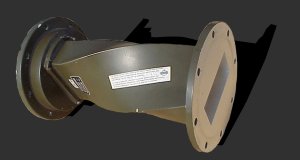Waveguides Bends and Twists
The size, shape, and dielectric material of a waveguide must be constant throughout its length for energy to move from one end to the other without reflections. Any abrupt change in its size or shape can cause reflections and a loss in overall efficiency. When such a change is necessary, the bends, twists, and joints of the waveguides must meet certain conditions to prevent reflections.
Bends
Waveguides may be bent in several ways that do not cause reflections. One way is the gradual bend shown in the right part of the following figure. This gradual bend is known as an E bend because it distorts the E fields. The E bend must have a radius greater than two wavelengths to prevent reflections.

 | |
| H - bend | E - bend |
Figure 1: Waveguide bends
Another common bend is the gradual H bend shown in the leftt part of the figure. It is called an H bend because the H fields are distorted when a waveguide is bent in this manner. Again, the radius of the bend must be greater than two wavelengths to prevent reflections.
A sharp bend in either dimension may be used if it meets certain requirements. Notice the two 45-degree bends in figure; the bends are 1/4·λ apart. The reflections that occur at the 45-degree bends cancel each other, leaving the fields as though no reflections have occurred.
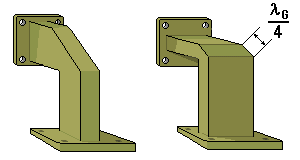
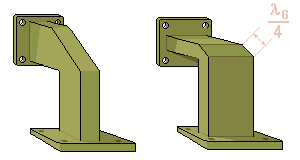
Figure 2: Waveguide bends
Twists
Sometimes the electromagnetic fields must be rotated so that they are in the proper phase to match the phase of the load. This may be accomplished by twisting the waveguide as shown in the figure. The twist must be gradual and greater than two wavelengths (2·λ).
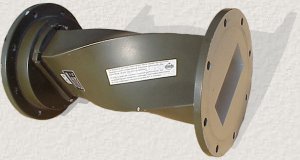
Figure 3: Waveguide twist
The flexible waveguide allows special bends which some equipment applications might require. It consists of a specially wound ribbon of conductive material, most commonly brass, with the inner surface plated with chromium. Power losses are greater in the flexible waveguide because the inner surfaces are not perfectly smooth. Therefore, it is only used in short sections where no other reasonable solution is available.
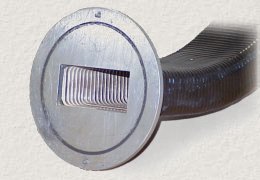
Figure 4: Flexible waveguide

Figure 4: Flexible waveguide

